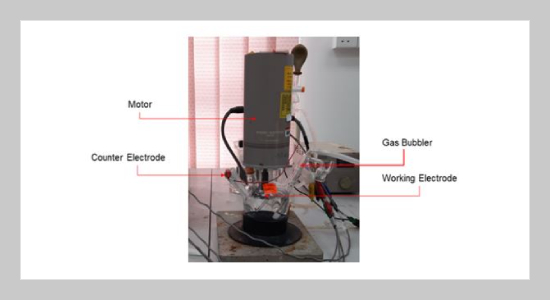REFERENCES
- [1] A. Z.Weber, S. Balasubramanian, and P. K. Das. “Proton exchange membrane fuel cells”. In: Advances in Chemical Engineering. 41. Elsevier, 2012, 65–144. DOI: 10.1016/B978-0-12-386874-9.00003-8.
- [2] Z.Wu, M. Song, J.Wang, and X. Liu, (2018) “Recent Progress in Nitrogen-Doped Metal-Free Electrocatalysts for Oxygen Reduction Reaction": 1–17. DOI: 10.3390/catal8050196.
- [3] S. Zhuang, B. B. Nunna, D. Mandal, and E. S. Lee, (2018) “A review of nitrogen-doped graphene catalysts for proton exchange membrane fuel cells-synthesis, characterization, and improvement" Nano-Structures and Nano-Objects 15: 140–152. DOI: 10.1016/j.nanoso.2017.09.003.
- [4] O. S. Soares, R. P. Rocha, A. G. Gonçalves, J. L. Figueiredo, J. J. Órfão, and M. F. Pereira, (2015) “Easy method to prepare N-doped carbon nanotubes by ball milling" Carbon 91: 114–121. DOI: 10.1016/j.carbon.2015.04.050.
- [5] I. Y. Jeon, H. J. Noh, and J. B. Baek, (2020) “Nitrogen-Doped Carbon Nanomaterials: Synthesis, Characteristics and Applications" Chemistry - An Asian Journal: DOI: 10.1002/asia.201901318.
- [6] M. Inagaki, M. Toyoda, Y. Soneda, and T. Morishita, (2018) “Nitrogen-doped carbon materials" Carbon: DOI: 10.1016/j.carbon.2018.02.024.
- [7] A. N. Fouda, E. S. M. Duraia, and A. A. Almaqwashi, (2020) “Facile and scalable green synthesis of N-doped graphene/CNTs nanocomposites via ball milling" Ain Shams Engineering Journal: DOI: 10.1016/j.asej.2020.04.011.
- [8] Y. She, J. Chen, C. Zhang, Z. Lu, M. Ni, P. H.-L. Sit, and M. K. Leung, (2017) “Oxygen Reduction Reaction Mechanism of Nitrogen-Doped Graphene Derived from Ionic Liquid" Energy Procedia 142: 1319–1326. DOI: 10.1016/j.egypro.2017.12.508.
- [9] L. Figueiredo and M. F. R. Pereira, (2016) “N-doped Carbon Nanotubes for the Oxygen Reduction Reaction in Alkaline Medium : Synergistic Relationship between Pyridinic and Quaternary Nitrogen": 2522–2530. DOI: 10.1002/slct.201600615.
- [10] R. Yadav and C. K. Dixit, (2017) Journal of Science: Advanced Materials and Devices 2: 141–149. DOI: 10.1016/j.jsamd.2017.05.007.
- [11] O. S. Soares, R. P. Rocha, A. G. Gonçalves, J. L. Figueiredo, J. J. Órfão, and M. F. Pereira, (2016) “Highly active N-doped carbon nanotubes prepared by an easy ball milling method for advanced oxidation processes" Applied Catalysis B: Environmental 192: 296–303. DOI: 10.1016/j.apcatb.2016.03.069.
- [12] S. Zhuang, B. B. Nunna, J. A. Boscoboinik, and E. S. Lee, (2017) “Nitrogen-doped graphene catalysts: High energy wet ball milling synthesis and characterizations of functional groups and particle size variation with time and speed" International Journal of Energy Research 41: 2535–2554. DOI: 10.1002/er.3821.
- [13] S. Zhuang, E. S. Lee, L. Lei, B. B. Nunna, L. Kuang, and W. Zhang, (2016) “Synthesis of nitrogen-doped graphene catalyst by high-energy wet ball milling for electrochemical systems" International Journal of Energy Research: DOI: 10.1002/er.3595.
- [14] C. Liu, X. Liu, J. Tan, Q.Wang, H.Wen, and C. Zhang, (2017) “Nitrogen-doped graphene by all-solid-state ballmilling graphite with urea as a high-power lithium ion battery anode" Journal of Power Sources 342: 157–164. DOI: 10.1016/j.jpowsour.2016.11.110.
- [15] R. Ranjan, R. S. Rai, and V. Bajpai, (2020) “A novel approach to synthesize nitrogen-doped graphene in aspects of milling energy" Diamond and Related Materials 110: 108116. DOI: 10.1016/j.diamond.2020.108116.
- [16] , (2016) “Functionalized graphene nanoplatelets from ball milling for energy applications" Current Opinion in Chemical Engineering: DOI: 10.1016/j.coche.2016.01.003.
- [17] Z. Wu, Y. Liang, E. Fu, J. Du, P. Wang, Y. Fan, and Y. Zhao, (2018) “Effect of ball milling parameters on the refinement of tungsten powder" Metals: DOI: 10.3390/met8040281.
- [18] N. A. Huzaifah, N. Sabli, K. K. Ying, N. U. Saidin, and H. S. Hilal, (2020) “Enhancement of Characteristics of Nitrogen-Doped Graphene Composite Materials Prepared by Ball Milling of Graphite with Melamine: Effect of Milling Speed and Material Ratios" Sains Malaysiana 49: 1745–1754. DOI: 10.17576/jsm-2020-4907-24.
- [19] A. R. D. Osa, P. Sanchez, and A. Romero, (2020) “Towards new routes to increase the electrocatalytic activity for oxygen reduction reaction of n-doped graphene nano fi bers" Journal of Electroanalytical Chemistry 878: 114631. DOI: 10.1016/j.jelechem.2020.114631.
- [20] K. Kakaei, G. Ghadimi, and K. Kakaei, (2020) “A green method for Nitrogen-doped graphene and its application for oxygen reduction reaction in alkaline media reduction reaction in alkaline media" Materials Technology 00: 1–8. DOI: 10.1080/10667857.2020.1724692.
- [21] , (2020) “Iron-based electrocatalysts for energy conversion: Effect of ball milling on oxygen reduction activity" Applied Sciences (Switzerland) 10: DOI: 10.3390/APP10155278.
- [22] J. J. Lee, M. Y. Oh, and K. S. Nahm, (2016) “Effect of Ball Milling on Electrocatalytic Activity of Perovskite La 0.6 Sr 0.4 CoO 3-δ Applied for Lithium Air Battery" Journal of The Electrochemical Society 163: DOI: 10.1149/2.0561602jes.
- [23] T. D. N. Van, S. Sufian, N. Mansor, and N. Yahya, (2014) “Characterization of carbon nanofibers treated with thermal nitrogen as a catalyst support using point-ofzero charge analysis" Journal of Nanomaterials: DOI: 10.1155/2014/631069.
- [24] W. Sudarsono, W. Y. Wong, K. S. Loh, E. H. Majlan, N. Syarif, K. Y. Kok, R. M. Yunus, K. L. Lim, and I. Hamada, (2020) “Sengon wood-derived RGO supported Fe-based electrocatalyst with stabilized graphitic N-bond for oxygen reduction reaction in acidic medium" International Journal of Hydrogen Energy: DOI: 10.1016/j.ijhydene.2020.05.158.
- [25] D. Guo, R. Shibuya, C. Akiba, S. Saji, T. Kondo, and J. Nakamura, (2016) “Active sites of nitrogen-doped carbon materials for oxygen reduction reaction clarified using model catalysts" 351: 361–366.
















